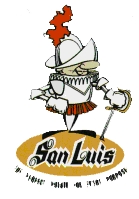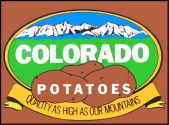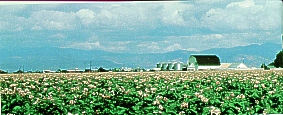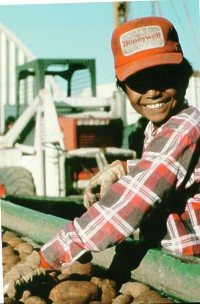

Potato's Past
The potato has become a staple on more than the American dinner plate. Potatoes pop up in jokes, greeting cards and toys, underscoring how much a part of our lives the potato has become. Inca indians in Peru were probably the first to grow potatoes in about 200 B.C. Spanish conquistadors exploring the New World spied Indians in South America feasting on the strange plant and took samples home, where Europeans received it with fear. The potato was shunned for years because it was from the same family as the deadly night shade plant. Before the end of the sixteenth century families of Basque sailors began to cultivate potatoes along the Biscay coast of Northern Spain.
Sir Walter Raleigh changed the potato's path in the early 15th century when he began growing 40,000 acres of the plant in Ireland. The potato was accepted as part of a daily diet along with buttermilk, which today's nutritionists say is a good mix. Over the years potatoes became a major food source in Ireland. In 1845-46 late blight, a fungus, destroyed the potato crop leading to the disater of the Irish Potato Famine.
It wasn't until Benjamin Franklin attended a dinner in France where 20 potato dishes were served that America's love affair with potatoes began. Franklin began growing what he called the ultimate vegetable. When President Thomas Jefferson served potatoes in the White House, the vegetable was destined for success.
But potatoes weren't accepted by the American public until the 1800s. In the late 1840s, blight hit the potato crop and hurled Ireland into a famine. Many Irishmen immigrated to this country, packing their love of potatoes with them.
In October 1195, the Potato became the first vegetable grown in Space. NASA and the University of WIsconsin, Madison, experimented with growing potatoes in space with the goal of feed future astronauts on long voyages or future space colonies.
Farmers began growing potatoes in Colorado's San Luis Valley about 1875, making it one of the oldest potato growing areas in the country. The Colorado Potato Administrative Committee adopted the symbol of the Little Conquistador in 1966 to tie Colorado potatoes with their past. As the reputation of the Valley's quality potatoes spread, the committee changed its logo to show off the surroundings, sporting the slogan, "Quality as High as Our Mountains."

|
 |
The snow-covered peaks of the Rocky Mountains jut up 14,000 feet to surround the fertile plateau of the San Luis Valley. Here, in the highest and largest alpine valley in the world where controlled crops are grown, the potato flourishes.
The San Luis Valley of Colorado

Agriculture has long been the basis of the economy in the San Luis Valley. Unique in world topography, the elevation of the valley floor is 7600 feet above sea level. The San Luis Valley is a large, flat intermountain valley that varies from 20 to 50 miles in width and is about 100 miles north to south. All crops are grown with irrigation water whose source is the abundant snow in the surrounding mountains. Crops are irrigated by some surface flooding or mainly by center pivot sprinklers. The principal crops grown here are potatoes, alfalfa, native hay, barley, wheat and vegetables like lettuce, spinach and carrots. The San Luis Valley produces 92% of Colorado's potatoes, 81% of the state's spring wheat, 73% of the barley, 30% of the oats, 76% of the spinach, 73% of the lettuce and 46% of the carrots. The San Luis Valley is ranked in the top five potato producing areas in the United States, both in acres planted and production. Nature helps ensure that the 65,000 acres planted in the Valley each year are of a high quality.
The Valley's spring and summer are filled with warm, sunny days and cool nights, the combination for a perfect growing season. The cool weather also contributes to the smoothness of the skin and reduces second-growth roughness. This, highest in the world, isolated alpine desert with its cold winters helps eliminate or reduce pest and disease problems, reducing our need for some pesticides. The harvest begins in September with about 98 percent of the crop going into storage before being shipped. A integrated pest program funded by the area growers reduces Green Peach aphid populations dramatically as well as the disease leafroll that this aphid transmits.

The soil in the Valley is a fertile, loose-packed loam. This quality is necessary because potatoes grow in the ground and the soil must be able to shift easily to allow for the potato's growth. Because the Valley receives less than seven inches of rain a year, it qualifies as a desert and must be irrigated. A natural underground water aquifer, recharged from runoff from heavy snowfall in the nearby mountains, offers a plentiful irrigation source. The modern center pivot sprinkler, used by almost all growers in the San Luis Valley, allows the grower to control the irrigation.
The San Luis Valley's central location also helps with crop distribution. The majority of the crop is shipped to the south, south-central, southeastern and the growing sunbelt areas of the United States.

Transportation has changed much since the late 1800s when the vegetables were hauled by wagon to mining camps. Then in the early 1880s, railroads serviced the area, sending shipments to farther markets. But in the 1960s, refrigerated semi-trailers began taking 97 percent of the San Luis Valley potato crop to its ever-expanding markets. Now a trailer can be loaded in the afternoon and deliver a shipment of potatoes to Dallas or Kansas City, for example, by the next morning.
Today's agri-businessmen have changed from yesterday's farmers who turned their crop over to a buyer or dealer to sell. New generation grower-shippers now market their own crops or store them in cooperative warehouses with other growers for future sale.
About 28 major potato warehouses pack and ship potatoes in the Valley, one of which is Mountain Valley Produce. Using ultra-modern equipment, potatoes can go from storage to warehouse to truck any day during the shipping season without taking the potatoes outdoors. About 95 percent of the crop is shipped to the nation's fresh market.
Before any shipment leaves the Valley, it is inspected by a U.S.D.A. representative. In 1941, a federal marketing order for potatoes grown in Colorado as well as a state marketing order was established. These orders, after several amendments, are still in effect, making Colorado one of four states under federal regulation and the only one with state control.
The state order authorizes the Colorado Potato Administrative Committee to function as an administrative subdivision of the state and represent all San Luis Valley growers. The committee is governed by 12 members elected from the local growers and shippers. They monitor quality, research, promotion and advertising.
The committee sets stringent size and grade regulations prior to the harvest and mandates government inspections for each load that leaves the Valley.